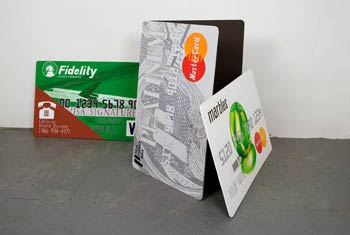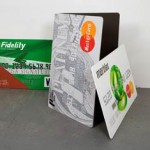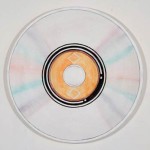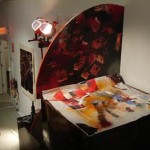By SCOTT ALBERG
Second Gallery featured the work of artists Tyler Drosdeck and Brendan Harman in its final exhibition before closing its doors. Though each exhibited separate projects and pieces, the two artists collaborated on the show’s conceptualization and decided to each call their respective installations Same Old . The commonly used saying “same old, same old” achieves its meaning because of and through its redundancy. In this dense and rewarding exhibition both Drosdeck and Harman find that redundancy can sometimes be very, very productive, and can lead toward the reformulation of old ideas into new kinds of language and expression.
The main form in Harman’s Same Old installation is a large, minimalist inspired sculpture jerryrigged together with masonite boards, some sort of gloss finish, glue and nails. Reminiscent in size and form of a Tony Smith or Robert Morris, the surface of the sculpture yields a faux rusted Cor-Ten steel finish that nods to Richard Serra and places the work firmly within recent reexaminations of 1960’s Minimalism. Lacking that generation’s characteristic slickness and detachment, Harman’s handmade monument reaches toward the gallery ceiling and evokes a rusted over industrial plant or some strange extraterrestrial structure. Monumental yet completely tentative in its execution, the sculpture awkwardly evokes the past (60’s Minimalism) and through its sheer materiality, form, and presence forces the viewer into a profound awareness of their current space. Recent art history becomes a spatialized mass of coagulated form and faux finish.
Practically filling the entire front gallery space, one manages to walk around it and inside, finding a chamber-like alcove and a blurred image of an artist’s studio cluttered with the tools of the trade. Also scattered about the structure are small sculptures comprised of what seem to be scraps from around the studio, such as glue bottles, wood, and found photographs which are covered in plaster and mounted onto wooden bases. Similar constructions also feature brushes encrusted with dry paint, cardboard (along the side of one reads the phrase, “Everyday is the same”), and tree branches collected, glued, and plastered into bouquets monumentalizing artistic labor. The entropic stillness of the larger sculpture is picked up in these smaller pieces as the tools of artistic labor become the degraded results of that labor. In these pieces tools, labor, and art crystallize into frozen forms characterized by their equilibrium and stillness.
In his exhibition of useless tools and remade ruins of recent art history, Harman articulates the difficult and compromised status of the work of art and of the artist in a world of globalized capital, disposable commodities and accelerated history. The shows other artist, Tyler Drosdeck, draws an explicit link between the art object and the inner workings of capital, the packaging of commodities, and their implied promise (yet almost always broken) of a better tomorrow. Drosdeck exhibits paintings on wood of credit cards enlarged to greater than life size. Either leaned against the wall or leaned against each other in a kind of “house of cards,” these works speak the extent to which artistic production and art history has been completely co-opted by the market. In dialogue with Harman, Drosdeck’s installation also calls to mind Richard Serra, specifically his 1968-69 One-Ton Prop (House of Cards) . This sly and damning reformulation of the lasting legacy of the 1960’s neo-avant garde as now nothing more than credit and capital on the brink of collapse, is ramified further by the artist’s choice to paint not activated credit cards, but dummy or promotional cards one often receives in the mail promising better rates and greater purchasing power. Here any separation between the materiality of the art object and the promise of and potential for greater wealth is utterly absent. Also exhibited are four 17 inch round paintings of the underside of compact discs. Again enlarged, this time to take on the dimensions of the now technologically obsolete record, these paintings yield only their surface. In their play with reflection, light, and color, they depict the subjugation of music and its constituent parts of time, rhythm, energy, and vitality to the logic of data and distribution.
Same Old by Harman and Same Old by Drosdeck both articulate a problematic space in which the contemporary art object finds itself. Claiming a certain legacy with the radical past of the 1960s while at the same time driven to the brink of historical irrelevance by globalization, biennial culture, and the market, the art in this show still manages to open a space where imaginative possibilities can emerge. In a world where increasingly “Everyday is the same”, insisting on the creative potentials embedded within redundancy might be one of the only possible ways forward.
- Tyler Drosdeck, Untitled (Fidelity), Untitled (Premier Platinum), Untitled (Marbles) and Untitled (American Express), House paint and acrylic paint on wood panel, 2007
- Tyler Drosdeck, Untitled Sculpture 5, acrylic on canvas, 2007
- Brendan Harman, Same Old, installation view, 2007
Second Gallery
A CONVERSATION WITH REBECCA GORDON by MATTHEW NASH in issue #65
"Same Old, Same Old" is on view June 9 - July 7, 2007 at Second Gallery.
All images are courtesy of the artists and Second Gallery.







